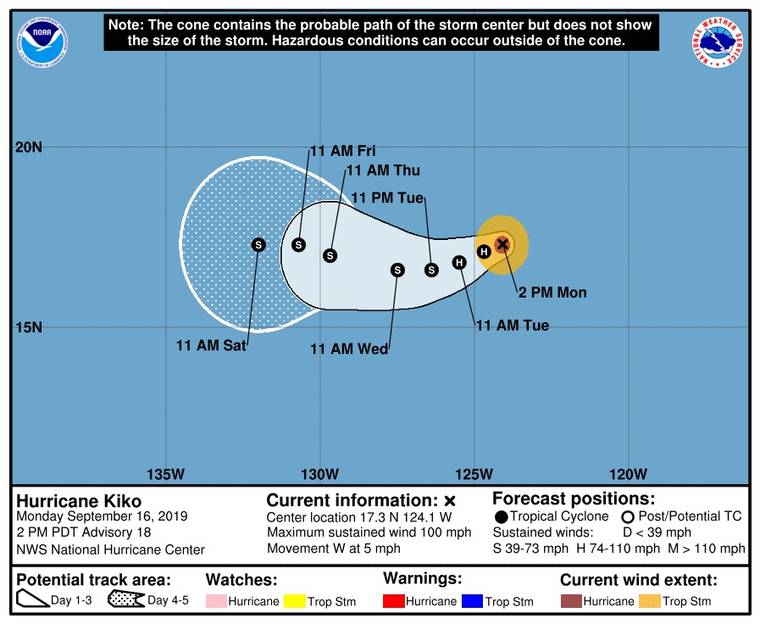In East Hawaii, predictions for a wet weekend failed to materialize and record heat temperatures were instead recorded.
Meanwhile in the Eastern Pacific, Hurricane Kiko strengthened into a Category 2 hurricane over the weekend, counter to forecasts that had it weakening into a tropical storm.
On Friday, despite a dark and rainy afternoon, the National Weather Service recorded a high temperature of 88 degrees at Hilo International Airport, tying the previous record high set in 2013.
And on a sweltering Sunday, the mercury hit 90 degrees in Hilo, tying the previous record set in 1972.
As of 11 a.m. today, the center of Hurricane Kiko was 2,035 miles east of Hilo. Maximum sustained winds are at 100 mph with locally higher gusts.
The storm is relatively small and slow moving, however, tracking to the west at 5 mph. Hurricane-force winds extend outward up to 15 miles from the
center and tropical-storm-force winds extend outward up to 60 miles from the center.
Forecasters at the National Hurricane Center in Miami predict the storm to take a west-southwestward turn on Tuesday, followed by a turn back to the west on Wednesday with that motion continuing into Thursday.
Weather watchers say the storm is slowly weakening and predict that trend to continue during the next couple of days. Then little change in strength is expected on Thursday.
Forecasters are also looking two disturbances off the Mexican coastline of which they predict are likely to develop into tropical cyclones.
The first is a small area of low pressure centered several hundred miles south-southwest of Manzanillo, Mexico, that forecasters say has started to organize.
“Any significant increase in organized thunderstorm activity will likely result in the formation of a tropical depression tonight or (Tuesday),” the forecast states.
The chances of this disturbance becoming a tropical cyclone in the next 48 hours is rated at 80%.
A second area of thunderstorm activity associated with a larger low-pressure area is closer to the southwest Mexican coast and is also becoming better organized, forecasters say. Its chances of becoming a tropical cyclone are even higher, with forecasters predicting a 90% chance of organization within 48 hours.
Closer to home, forecasters at the Central Pacific Hurricane Center in Honolulu are monitoring three disturbances, but two are southwest of Hawaii and unlikely to affect island weather.
The third, described as “an elongated area of low pressure” is about 800 miles southeast of the Big Island.
“Slow development is possible during the next several days while the area slowly moves westward,” the forecast states.
The chance of formation into a tropical cyclone is low, however, forecasters say — almost nil in the next 48 hours and about 20% in the next five days.
Email John Burnett at jburnett@hawaiitribune-herald.com.



